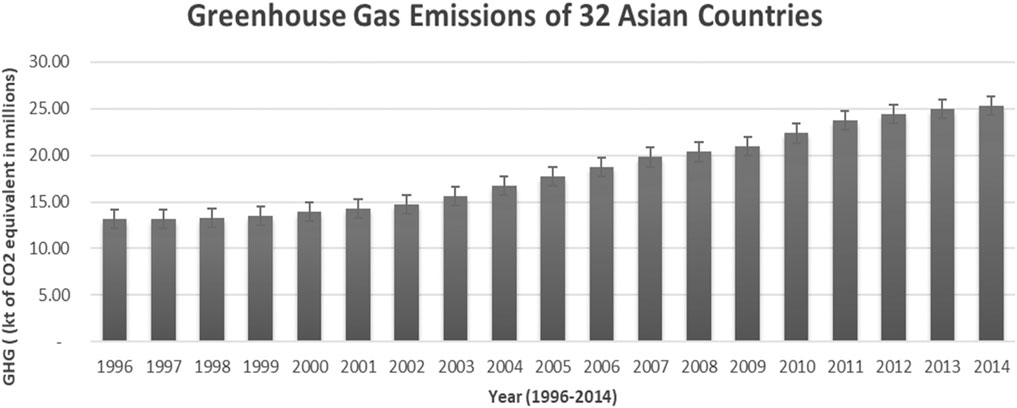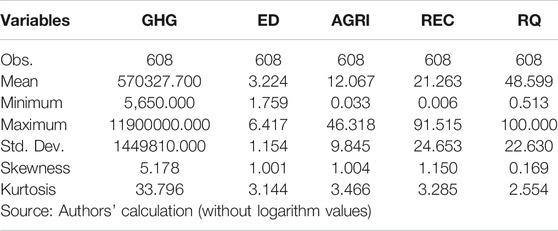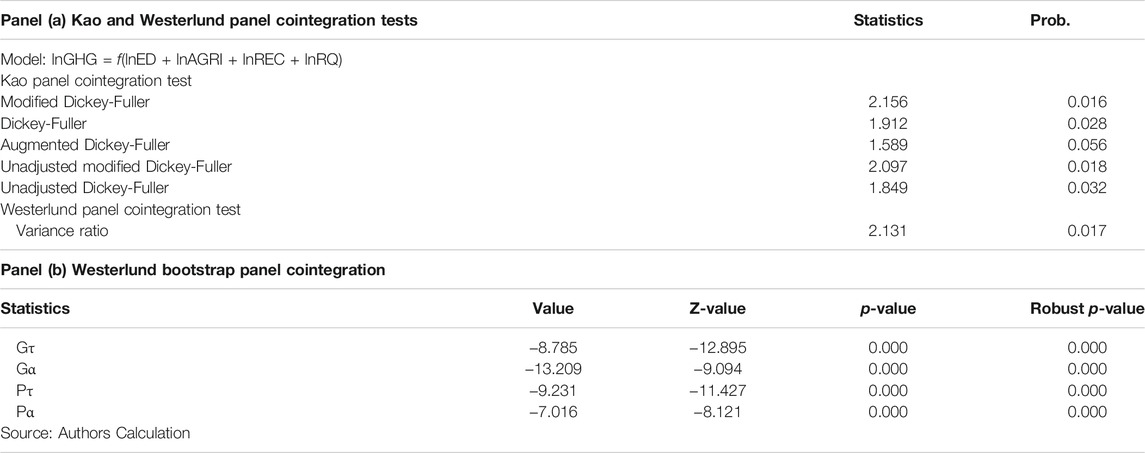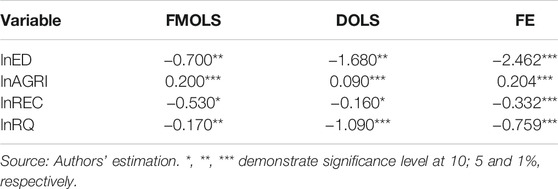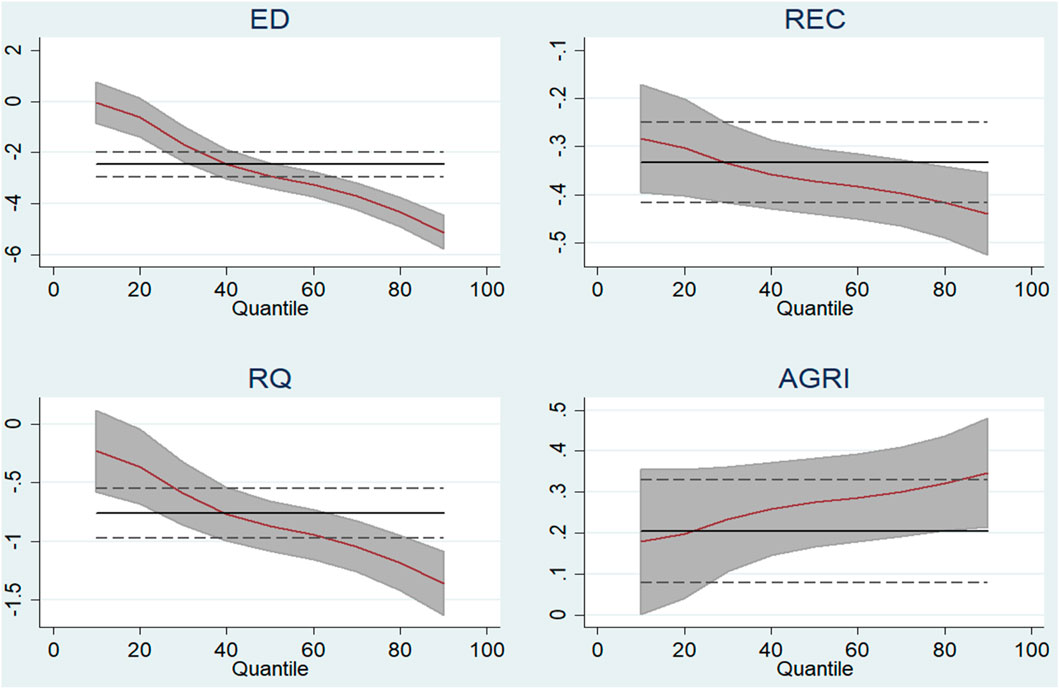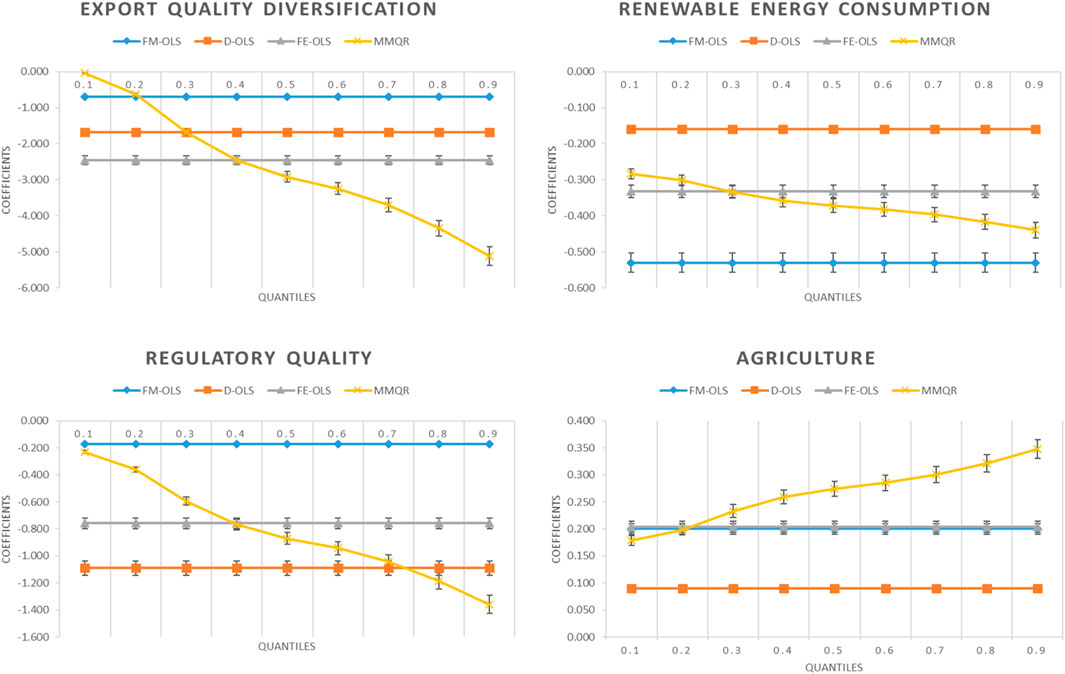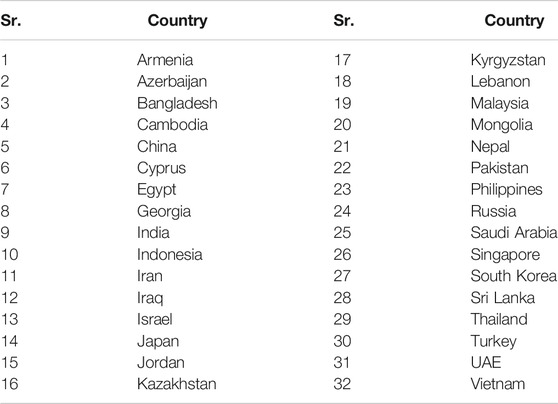Do Diversified Export, Agriculture, and Cleaner Energy Consumption Induce Atmospheric Pollution in Asia? Application of Method of Moments Quantile Regression
- 1Lahore Business School, University of Lahore, Lahore, Pakistan
- 2School of Economics and Management, Huzhou University, Huzhou, China
- 3Department of Economics (DoE), Birmingham Business School (BBS), University House, College of Social Sciences (CoSS), University of Birmingham, Birmingham, United Kingdom
- 4School of Economics, Sichuan University, Chengdu, China
- 5Faculty of Economics and Administrative Sciences, Department of Economics, Osmaniye Korkut Ata University, Osmaniye, Turkey
Sustainable development remains unattainable unless we move to reduce the negative impact of economic factors on environmental quality. It is noteworthy to provide new evidence on whether and how the empirical association between export diversification, agricultural value-addition, renewable energy, and regulatory quality with greenhouse gas (GHG) emissions evolved in Asian countries from 1996 to 2014. The study examines the relationships between these variables using current panel data techniques. The econometric procedure includes second-generation cointegration and unit root tests together with a novel Method of Movements Quantile Regression (MMQR). This approach offers an asymmetric relationship between the variables and is very robust to outliers compared to traditional quantile regression. The empirical outcomes show that export diversification, renewable energy, and regulatory quality are significantly and negatively associated with GHG emissions. In contrast, agricultural value-added in Asia has become a source of increased GHG emissions. Our findings are also robust with alternate specifications, including fully modified, dynamic and fixed effect regressions. This study will help policymakers for diversifying their export portfolio while ensuring a sustainable environment in Asia.
Introduction
Gradually changing climate and ongoing environmental degradation are the most obvious challenges facing the entire world today. Greenhouse gas (GHG) emissions are expected to reach 416 ppm by the end of 2021, bestowing the highest level in history (MBE, 2021). This huge increase in GHG has a negative impact on the sustainable future of humanity in terms of economy and health. Therefore, both developed and developing nations prioritize environmental protection and energy security to accomplish the 2030 Sustainable Development Goals (Merchant, 2016; Sharma R. et al., 2021). Governments care about international trade by making economic gains after satisfying social and non-social interest groups. However, economies based on the export of a specific and dirty commodity cause significant environmental pollution. To curtail dependence on specific exports and to achieve sustainable earnings, the World Bank (2021) and International Monitoring Fund (IMF) encourage countries to diversify their exports.
Not only have that, but this study also instigate export diversification is inevitable for the economy for several reasons. First, diversified exports refer to the process by which the risk of international trade can be minimized (Bertinelli et al., 2006). Second, it has a positive impact on economic growth (Grossman and Helpman, 1991). Third, it permits economies to have a stabilized balance of payments and helps to prevent trade shocks (McIntyre et al., 2018). Due to a sufficient number of resources, export diversification is characterized as a phenomenon that is considered an essential part of structural change and development (Ali, 2017; Goya, 2014) and seems to affect the environmental quality (Jebli et al., 2016).
It is not unusual for there to be a reciprocal association between agriculture and the environment. On the one hand, a considerable amount of GHG emissions is produced by agricultural production based on traditional and outdated practices (Frank et al., 2017; Zurek et al., 2020; Pata, 2021a). On the other hand, agriculture is highly dependent on the environment for water, genetic material and land, although it seems to lead to environmental degradation. Intergovernmental Panel on Climate Change (IPCC) disclosed that from 2007 to 2016, the use of land and agriculture was responsible for almost 23% of GHG emissions. In this sense, IPCC predicts ∼21–37% GHG emissions by 2050 (Sharma R. et al., 2021). These consequences draw new avenues to raise questions:
1) Whether and how is export diversification seen to promote a sustainable environment?
2) Do agricultural value addition, renewable energy, and regulatory quality influence environmental quality?
Asia is presumed a potential region to address the above queries. First, in terms of the developing countries, Asia is a hub of the fastest emerging nations, such as China, which is the diversified and largest exporter in the world. Second, Asia is the most populous region in the world and is home to more than half of human beings (Asian Development Bank, 2017). Not only that, meeting the agricultural (farming and food) needs of the people remains a vulnerable challenge for this region. Third, Asia is the most critical part of climate change. Over the last decade, this region has been the largest emitter of GHG in the world (Le et al., 2020). Lastly, 93 of the 100 most populous cities in the world are located in Asia (IRENA, 2018). This region has remarkable potential for switching to renewable energy sources (Zafar et al., 2021). Therefore, it is crucial to objectively evaluate Asian nations by discovering the impact of renewable energy on GHG emissions to identify the potential for economic and environmental gains. Figure 1 exhibits the GHG emissions of 32 Asian countries from 1996 to 2014, illustrating that emissions are perpetually growing and have almost doubled in 2 decades.
Existing literature has scrutinized the links between export diversification, agricultural value-addition, renewable energy, and regulatory quality with carbon dioxide (CO2) emissions on a piecemeal basis, which left several margins our research addresses. To the best of our knowledge, this study contributes to the current literature in several ways. First, this study observes the influence of a unique combination of variables including export diversification, agricultural value addition, renewable energy and regulatory quality on GHG emissions in 32 emerging Asian economies. Second, this study employed a novel panel data estimator, Method of Movements Quantile Regression (MMQR), which Machado and Silva (2019) recently proposed. This method deals well with the outliers and provides estimations at location, scales and quantiles. Third, this study provides robust findings with alternative methods including fully modified, dynamic and fixed effect (FMOLS, DOLS & FE) estimators. Finally, this study provides non-linear associations among variables through quantile distributions.
The rest of the sections of this study are arranged as follows; Literature Review explains the review of the existing literature, while Data methodology narrates the data and methodology. Empirical Results interprets and enumerates the findings, while Conlcusion concludes the study and reports policy implications.
Literature Review
Over the last 2 decades, there has been much discussion about the possible determinants of environmental degradation. In this regard, various researchers have thoroughly investigated the potential reasons for the increase in GHG emissions employing different model specifications. To consider the extent of the linkages between export diversification, agriculture, renewable energy consumption, regulatory quality and environmental quality, we discuss the following recent literature.
The nexus between export diversification and environmental quality has recently been explored in the literature. For instance, Shahzad et al. (2020) scrutinized the impact of product diversification and intensive margin on CO2 emissions for panel data of 63 developing and developed economics from 1971 to 2014. The study results presented the negative influence of diversification on the environment. Hu et al. (2020) examined panel data of both 93 developing and 35 developed nations by employing augmented mean group (AMG) and common correlated effect mean group (CCEMG) techniques. They established a negative influence of product diversification on CO2 emissions for developed nations while positively contributing to developing countries. Li et al. (2021) applied a novel statistical technique and found that export diversification mitigates CO2 emissions from 1989 to 2019 in China. In the case of BRICS countries, Sharma R. et al. (2021) reported the favorable interconnection of export diversification with air quality. Then, Wang et al. (2021) analyzed the role of export product quality on CO2 emissions in the ten largest economies by using DOLS and FMOLS. They found a negative and significant association between export product quality and the environment. Similarly, Fareed et al. (2021) studied the influence of export diversification and renewable energy on load capacity factor using a Fourier quantile causality technique in Indonesian from 1965Q1 to 2014Q4. They concluded that export diversification and renewable energy consumption are significantly increased load capacity factor and thus improved environmental quality in Indonesia.
The literature mainly talks about the negative relationship between export diversification and environmental pollution. On occasions, however, export diversification is positively linked with the environment. For instance, Mania (2020) noted that export diversification has a positive and significant influence on the environment. Moreover, Wang et al. (2020) observed the linkage of ecological innovation and export diversification with the environment from 1900 to 2017 for G-7 countries. Their results show that export diversification refers to the process by which the intensity of CO2 emissions increases.
In the case of agriculture and the environment, it is necessary to evaluate the connection of farming with the atmosphere from both perspectives. For instance, agriculture based solely on non-renewable energy, biomass burning and fertilizer use are considered as significant contributors to the rising GHG emissions (Qiao et al., 2019). Ismael et al. (2018) concluded that agricultural activities are positively linked with CO2 emissions in Jordan. Appiah et al. (2018) examined the causal connection between agriculture (livestock and crop production) and carbon emissions by applying FMOLS and DOLS in BRICS countries for panel data from 1973 to 2013. Their inclusive outcomes suggest that agriculture appears to lead to environmental degradation.
Similarly, Pata (2021a) used Fourier ARDL cointegration and Fourier causality test for BRIC countries from 1971 to 2016 and concluded that agriculture increases CO2 emissions in China. Besides, Sharma G. D. et al. (2021) probed the agriculture value-added and renewable energy consumption with GHG emissions in countries of The Bay of Bengal Initiative for Multi-Sectoral Technical and Economic Cooperation. They found a U-shaped connection between agriculture and GHG emissions. Contrary to general opinion, Aziz et al. (2020) reported that agriculture reduces pollution in Pakistan.
The interconnection between renewable energy consumption and greenhouse gas emissions can be discussed under the following two segments. Firstly, there is a plethora of research reporting a negative association between renewable energy and GHG emissions. For example, Bilgili et al. (2016) utilized panel FMOLS and DOLS estimators for 17 OECD countries from 1977 to 2010 and noted that renewable energy reduces CO2 emissions. Fuinhas et al. (2017) studied the association of renewable energy and carbon emissions by employing panel estimations for Latin American countries. They suggested that renewable energy sources are helpful in reducing CO2 emissions. The impact of renewable and non-renewable energy on the environment was investigated on panel data of 19 economies from 1990 to 2014 in Africa. In addition, Akram et al. (2020) examined the influence of energy efficiency and renewable energy consumption on CO2 emissions by using hidden panel cointegration and non-linear ARDL approaches for BRICS countries from 1990 to 2014. They suggested that positive shocks in energy efficiency and renewable energy consumption significantly decrease carbon emissions in the long run. Nathaniel and Iheonu (2019) concluded that renewable energy is negatively while non-renewable energy is positively associated with the environment. Similarly, Isik et al. (2020) found that renewable energy has a negative impact on CO2 emissions in France. In addition, Pata (2021b) confirmed the reducing role of renewable energy on CO2 emissions in the United States. However, secondly, some studies have found no association between renewable energy and CO2 emissions. According to the study of Al-Mulali et al. (2015), renewable energy has no significant effect on CO2 emissions in Vietnam. Pata (2018) concluded that renewable and clean energy forms are not adequately used to reduce CO2 emissions in Turkey. Using the augmented ARDL method, Pata and Caglar (2021) emphasized that renewable energy does not help to minimize environmental pollution in China.
A few studies have shed light on the impact of regulatory quality on the environment. This study is motivated by Gungor et al. (2021) in the direction that regulatory quality exerts a negative and significant association with the environment in South Africa. Similarly, Adedoyin et al. (2020) utilized balanced panel data from 1990 to 2014 and reported that regulatory quality plays a role in preventing environmental erosion. In contrast, Ibrahim and Ajide (2021) examined environmental quality using BRICS nations ranging from 1996 to 2018 and clarified that regulatory quality and financial development escalate CO2 emissions.
In conclusion, the above discussion has shown that the existing literature has not clarified and conclude the true relationship between export diversification, agriculture, renewable energy, regulatory quality and environmental pollution in developed and emerging economies worldwide.
Data and Methodology
Data and Model
To accomplish the objective of the study, we investigated the impact of export diversification, agricultural value-addition, renewable energy consumption and regulatory quality on GHG emissions using an annual balanced panel data of 32 Asian economies from 1996 to 2014. The list of selected Asian countries can be found in Appendix A. The description, unit of measurement and data sources are reported in Table 1.
The annual data of GHG emissions (kt of CO2 equivalent), agriculture value-added (% of GDP) and renewable energy use (% of total energy) is compiled from WDI. In contrast, data on export diversification (overall exports changes) is collected from the IMF. The annual data of regulatory quality (governance dimension) is gathered from WGI. Based on the existing literature, we analyze the following model.
Panel Estimation Techniques
To make a comparison, we employ FMOLS, DOLS and FE estimators. The FE technique is upgraded with Driscoll and Kraay standard errors (Driscoll and Kraay, 1998), and is robust to general forms of autocorrelation, cross-sectional dependence and heterogeneity up to certain lags (Le et al., 2020; Pedroni, 2004). The FMOLS is efficient enough to overcome heterogeneity problems with variations in the means (Pedroni, 2004). DOLS is found to be unbiased compared to FMOLS and FE in an infinite sample size. Using Monti Carlo simulations, Kao and Chiang (1999) extended the DOLS estimator to panel data settings. DOLS can handle endogeneity problems through the augmentation of lagged and leading differences.
A panel quantile regression is a better alternative to overcome the issues of previous techniques and examine the heterogeneous and distributional effects across various quantiles (Sarkodie and Strezov, 2019). The panel quantile regression was initially proposed by Koenker and Bassett (1978), and is used to estimate the dependent conditional mean and variance with respect to the explanatory parameters. However, to meet the objective of this study, we employed the Method of Moments Quantile Regression with the fixed effects method proposed by Machado and Silva (2019). MMQR, whilst robust to outliers and within panels, do not assume unobserved heterogeneity (Ike et al., 2020). This technique is efficient enough to account for the covariance effect of conditional heterogeneity in the determinants of GHG emissions. Rather than just shifting the means, it allows individual effects to affect the whole distribution (Koenker, 2004). The estimate of the conditional quantiles Qy
where the probability is
In Equation 4,
Empirical Results
In this section, we explain and discuss the findings. Table 2 presents the summary statistics (i.e., mean, minimum, maximum, standard deviation, skewness, and kurtosis) of the selected variables. The mean value of GHG emissions is 570,328 (kt of CO2 equivalent), while the mean values for export diversification, agriculture, renewable energy and regulatory authority are 3.22, 12.07, 21.26 and 48.60, respectively. GHG emissions have the highest standard deviation (1,448,810), whereas ED has the lowest (1.154). Furthermore, Table 2 clarifies that the skewness is positive for all factors in the study.
To assess the existence of cross-sectional dependence (CSD) among 32 Asian countries, we utilize the CSD test proposed by Pesaran (2004). This CDS test is efficient enough to distort the true parameters of the coefficient estimates. Due to unobserved common factors, the CSD test can eliminate the efficiency gains of panel data (Phillips and Sul, 2003). Table 3 explains the presence of CSD in two variables, including GHG emissions and agricultural value-added, while the remaining three variables show no CSD. The presence of CSD implies that the first generation unit root tests is inadequate and suggest the application of second-generation unit root tests. Therefore, to address this issue and obtain robust coefficient estimates, we employ the Cross-sectional Augmented Dickey-Fuller (CADF) test of Pesaran (2007).
The findings of Table 3 clarify that all variables are stationary at the first difference. Therefore, in the next step, we examine the cointegration relationship between the variables and report the results in Table 4.
In order to ascertain the presence of non-spurious long-run cointegration among the variables, we employ Kao and Westerlund’s panel cointegration tests and Westerlund (2007) bootstrap panel cointegration approach. Based on Engle and Granger (1987) methodology, Kao and Westerlund’s cointegration tests provide a compendium framework for panel cointegration testing. Table 4 elucidates that the null hypothesis of no cointegration is rejected in Panel (a), as six different test statistics and their probability values prove the existence of long-run cointegration. In addition, Panel (b) reports that four additional tests are proposed with the null of no-cointegration following the Westerlund bootstrap technique. These tests relax the compulsion of common factor restrictions on residual dynamics (Kremers et al., 1992). Using the Westerlund bootstrap approach, we can obtain robust critical findings by minimizing the biasing effects of the CSD. From the second-generation panel cointegration approach in Panel b, we find that four tests, including Gτ, Gα, Pτ and Pα are significant at the 1% level and support the robustness of the long-run cointegration. After determining the cointegration relationship, we perform elasticity calculations and summarize the results of mean based-estimators in Table 5.
The results draw a comparison among panel estimation procedures, e.g., FMOLS, DOLS and FE for Asian countries. Obviously, the coefficients resulting from these specifications, although significant at different levels, are closer to each other. The findings show that export diversification negatively and significantly affects GHG emissions. A 1% improvement in export diversification mitigates GHG emissions by −0.70%, −1.68% and −2.46% in the case of FMOLS, DOLS and FE, respectively. These empirical results are corroborated with the findings of Li et al. (2021), Shahzad et al. (2020) and Wang et al. (2021), but contradict Mania (2020) and Wang et al. (2020). Agricultural value-added is the most significant variable in all estimates. A percentage rise in agricultural value-added positively influences GHG emissions by 0.20% for both FMOLS and FE, while 0.09% for DOLS. These findings are similar to those of Qiao et al. (2019) and Sharma R. et al. (2021) while opposite to Aziz et al. (2020).
Moreover, renewable energy consumption shows a negatively significant interconnection with GHG emissions for all three specifications. A 1% change in REC brings variations in GHG emissions by −0.53% in the case of FMOLS, while it is −0.16% and −0.33% in the case of DOLS and FE, respectively. The findings are in line with Fuinhas et al. (2017), Nathaniel and Iheonu (2019), and Pata (2021b). In addition, the regulatory authority reports an indirect relationship with GHG emissions. From the table, it can be seen that a 1% change in the regulatory quality preserve the environment between −1.09% and −0.17% for all three specifications. This finding is consistent with Adedoyin et al. (2020) and Gungor et al. (2021).
The outcomes of the MMQR approach presented in Table 6 assess the relationship of export diversification, agriculture, renewable energy and regulatory quality with GHG emissions in 32 Asian countries. A negative and significant influence of export diversification on emissions can be observed across all quantiles (except for the 10th quantile). When the heterogeneous coefficients of export diversification increase through the 10th to 90th quantiles, the intensity of GHG emissions decreases from −0.03 to −5.12. A point that emerges from the findings is that more ED appears to lead to a favorable direction by preserving the environment (Shahzad et al., 2020; Li et al., 2021; Wang et al., 2021). In the case of agriculture, the results exert statistically significant and heterogeneous coefficients among quantiles. The positive coefficients clarify that the linkage of agriculture to GHG emissions increases as we move from the lower to the upper quantiles. A 1% increase in agriculture implies a 0.18–0.35% increase in GHG emissions. At the highest quantile, the coefficient value of agriculture is the utmost, demonstrating that the environment deteriorates as agriculture moves from the 10th to the 90th quantile. The findings are consistent with those of Qiao et al. (2019) and Sharma R. et al. (2021).
However, the use of renewable energy has vigorously contributed to diminishing the opposing effects on society and the environment by providing solutions to fulfil the Sustainable Development Goals. In addition, Table 6 elucidates that renewable energy has a negative and heterogeneous impact on GHG emissions across all quantiles in Asian economies. The larger coefficient value states that renewable energy refers to the process of reducing GHG emissions by protecting the environment (Fuinhas et al., 2017; Nathaniel and Iheonu, 2019). In the context of regulatory authority, the findings are consistent with the existing literature and present that regulatory authority is a solution to minimize GHG emissions. From the lower to upper quantiles, the coefficient value of regulatory authority, although insignificant in the 10th quantile, has a negative and heterogeneous effect ranging from −0.23 to −1.36. Regulatory quality is a policy that seems to promote some social goods beyond the benefits of economic activities, such as environmental preservation (Adedoyin et al., 2020; Gungor et al., 2021). The dynamics of the parameter estimates across different quantiles are depicted in Figure 2. The estimated coefficients appear to follow distinct trajectories than their linear estimates (OLS type), suggesting that the coefficients respond differently across quantiles.
Figure 3 compares the estimated coefficients for all specifications used, including MMQR, FE, DOLS and FMOLS. The coefficient approach of MMQR is heterogeneous and provides a vibrant image in all quantiles, while the coefficients of DOLS, FMOLS, and FE are static. Figure 2 represents that the coefficients of export diversification decrease from the lower to the upper quantiles, which indicates that more diverse export is favorable to the environment. Moreover, the coefficients of agricultural value-added are moving upward in the MMQR approach, representing that agriculture based on non-renewable sources in Asian countries is a poor motive for increasing the intensity of GHG emissions. There is an urgent need to promote advanced and eco-friendly procedures to escalate agricultural production while achieving the goal of a sustainable environment. In contrast, the coefficients of renewable energy and regulatory quality have effectively minimized the adverse effects of economic activities on society and the environment by providing reasonable solutions that help policymakers make decisions that can lead to environmentally friendly growth. Therefore, it is obvious that MMQR is an ideal and efficient technique when comparing all panel estimators to explain an inclusive demonstration of association among variables.
Conclusion
As a contribution to the environment-related literature, we explored the impact of export diversification, agricultural value-added, renewable energy, and regulatory quality on GHG emissions, taking Asia as a sample. To achieve the objectives of the study, we employ a novel technique, Method of Movements Quantile Regression (MMQR), recently proposed by Machado and Silva (2019). Clearly, MMQR is an ideal technique than the traditional panel quantile regression to explain an inclusive demonstration of association among variables at quantile distributions. This method is fierce against outliers and gives accurate estimates. Besides, we applied alternative methods such as FMOLS, DOLS and FE to get robust results.
The results of the study show that export diversification has a negative and significant impact on GHG emissions across all quantiles. On the one hand, higher export diversity tends to lead in a positive direction by conserving the environment. Agriculture, on the other hand, exerts a statistically significant and heterogeneous positive influence on the environment. The positive coefficients clarify that the interconnection of agriculture with GHG emissions is positive while moving from lower to upper quantiles. Renewable energy has a negative and heterogeneous impact on GHG emissions across all the quantiles. Therefore, renewable energy consumption has been vigorously contributing to diminishing the opposing effects on society and the environment through providing solutions to fulfil the purpose of sustainable development. In the context of regulatory authority, the findings present that regulatory quality is necessary to reduce GHG emissions.
Based on the findings of the study, policymakers in the Asian region should be encouraged to focus on export diversification, development of renewable energy sources and perceptions of regulatory quality policies to achieve the goals of green and clean energy production and a sustainable environment. Achieving these goals will be easier if a portion of the revenue generated from export diversification is spent on environmental purposes. Moreover, for a greener future for Asian countries, it is necessary to expand the use of renewable energy and adapt environmental technologies to the production process. Since overpopulation and the consumption of Asian countries are polluting the environment, these societies should be made more aware of the advantages of using and promoting renewable energies. Furthermore, better regulatory quality by Asian governments can contribute to environmental development by facilitating the use of renewable energy and diversification of exports. Therefore, policymakers in the Asian region should pursue environmental policies that simultaneously diversify exports, promote renewable energy, and increase regulatory quality. This work offers both professionals and academics further insight into future research that contextualizes export diversification and agriculture to examine additional movements in environmental quality around the world.
Data Availability Statement
The raw data supporting the conclusions of this article will be made available by the authors, without undue reservation.
Author Contributions
MR: Writing Original Draft, Software, Formal analysis. ZF: Data Curation, Conceptualization, Writing Original Draft, Writing - Review & Editing, Resources. SS: Writing - Review & Editing, Investigation. AK: Writing - Original Draft, Investigation. UP: Writing Original Draft, Writing - Review & Editing, Resources.
Conflict of Interest
The authors declare that the research was conducted in the absence of any commercial or financial relationships that could be construed as a potential conflict of interest.
Publisher’s Note
All claims expressed in this article are solely those of the authors and do not necessarily represent those of their affiliated organizations, or those of the publisher, the editors, and the reviewers. Any product that may be evaluated in this article, or claim that may be made by its manufacturer, is not guaranteed or endorsed by the publisher.
References
Adedoyin, F. F., Gumede, M. I., Bekun, F. V., Etokakpan, M. U., and Balsalobre-Lorente, D. (2020). Modelling Coal Rent, Economic Growth and CO2 Emissions: Does Regulatory Quality Matter in BRICS Economies. Sci. Total Environ. 710, 136284. doi:10.1016/j.scitotenv.2019.136284
Akram, R., Majeed, M. T., Fareed, Z., Khalid, F., and Ye, C. (2020). Asymmetric Effects of Energy Efficiency and Renewable Energy on Carbon Emissions of BRICS Economies: Evidence from Nonlinear Panel Autoregressive Distributed Lag Model. Environ. Sci. Pollut. Res. Int. 27 (15), 18254–18268. doi:10.1007/s11356-020-08353-8
Al-Mulali, U., Saboori, B., and Ozturk, I. (2015). Investigating the Environmental Kuznets Curve Hypothesis in Vietnam. Energy Policy 76, 123–131. doi:10.1016/j.enpol.2014.11.019
Ali, M. (2017). Determinants of Related and Unrelated export Diversification. Economies 5 (4), 50. doi:10.3390/economies5040050
Appiah, K., Du, J., and Poku, J. (2018). Causal Relationship between Agricultural Production and Carbon Dioxide Emissions in Selected Emerging Economies. Environ. Sci. Pollut. Res. 25 (25), 24764–24777. doi:10.1007/s11356-018-2523-z
Asian Development Bank (2017). A Region at Risk: The Human Dimensions of Climate Change in Asia and the Pacific Asian Development Bank. doi:10.22617/TCS178839-2
Aziz, N., Sharif, A., Raza, A., and Rong, K. (2020). Revisiting the Role of Forestry, Agriculture, and Renewable Energy in Testing Environment Kuznets Curve in Pakistan: Evidence from Quantile ARDL Approach. Environ. Sci. Pollut. Res. 27 (9), 10115–10128. doi:10.1007/s11356-020-07798-1
Ben Jebli, M., Ben Youssef, S., and Ozturk, I. (2016). Testing Environmental Kuznets Curve Hypothesis: The Role of Renewable and Non-renewable Energy Consumption and Trade in OECD Countries. Ecol. Indicators 60, 824–831. doi:10.1016/j.ecolind.2015.08.031
Bertinelli, L., Cardi, O., Pamukçu, T., and Strobl, E. (2006). The Evolution of the Distribution of Plant Size: Evidence from Luxemburg. Small Bus Econ. 27 (4-5), 301–311. doi:10.1007/s11187-005-8571-z
Bilgili, F., Koçak, E., and Bulut, Ü. (2016). The Dynamic Impact of Renewable Energy Consumption on CO 2 Emissions: A Revisited Environmental Kuznets Curve Approach. Renew. Sust. Energ. Rev. 54, 838–845. doi:10.1016/j.rser.2015.10.080
Chen, B., McCoskey, S. K., and Kao, C. (1999). Estimation and Inference of a Cointegrated Regression in Panel Data: A Monte Carlo Study. Am. J. Math. Manag. Sci. 19 (1-2), 75–114. doi:10.1080/01966324.1999.10737475
Driscoll, J. C., and Kraay, A. C. (1998). Consistent Covariance Matrix Estimation with Spatially Dependent Panel Data. Rev. Econ. Stat. 80 (4), 549–560. doi:10.1162/003465398557825
Engle, R. F., and Granger, C. W. J. (1987). Co-integration and Error Correction: Representation, Estimation, and Testing. Econometrica 55 (2), 251–276. doi:10.2307/1913236
Fareed, Z., Salem, S., Adebayo, T. S., Pata, U. K., and Shahzad, F. (2021). Role of export Diversification and Renewable Energy on the Load Capacity Factor in Indonesia: A Fourier Quantile Causality Approach. Front. Environ. Sci. 434. doi:10.3389/fenvs.2021.770152
Frank, S., Havlík, P., Soussana, J.-F., Levesque, A., Valin, H., Wollenberg, E., et al. (2017). Reducing Greenhouse Gas Emissions in Agriculture without Compromising Food Security. Environ. Res. Lett. 12 (10), 105004. doi:10.1088/1748-9326/aa8c83
Fuinhas, J. A., Marques, A. C., and Koengkan, M. (2017). Are Renewable Energy Policies Upsetting Carbon Dioxide Emissions? the Case of Latin America Countries. Environ. Sci. Pollut. Res. 24 (17), 15044–15054. doi:10.1007/s11356-017-9109-z
Goya, D. (2014). “The Multiple Impacts of the Exchange Rate on export Diversification,” in Cambridge Working Papers in Economics (Cambridge, UK: CWPE 1436).
Grossman, G. M., and Helpman, E. (1991). Innovation and Growth in the Global Economy. Cambridge, UK: MIT press.
Güngör, H., Abu-Goodman, M., Olanipekun, I. O., and Usman, O. (2021). Testing the Environmental Kuznets Curve with Structural Breaks: the Role of Globalization, Energy Use, and Regulatory Quality in South Africa. Environ. Sci. Pollut. Res. 28 (16), 20772–20783. doi:10.1007/s11356-020-11843-4
Hu, G., Can, M., Paramati, S. R., Doğan, B., and Fang, J. (2020). The Effect of Import Product Diversification on Carbon Emissions: New Evidence for Sustainable Economic Policies. Econ. Anal. Pol. 65, 198–210. doi:10.1016/j.eap.2020.01.004
Ibrahim, R. L., and Ajide, K. B. (2021). The Dynamic Heterogeneous Impacts of Nonrenewable Energy, Trade Openness, Total Natural Resource Rents, Financial Development and Regulatory Quality on Environmental Quality: Evidence from BRICS Economies. Resour. Pol. 74, 102251. doi:10.1016/j.resourpol.2021.102251
Ike, G. N., Usman, O., and Sarkodie, S. A. (2020). Testing the Role of Oil Production in the Environmental Kuznets Curve of Oil Producing Countries: New Insights from Method of Moments Quantile Regression. Sci. Total Environ. 711, 135208. doi:10.1016/j.scitotenv.2019.135208
International Monetary Fund (2021). Export Diversification and Quality. Available at: https://data.imf.org/?sk=A093DF7D-E0B8-4913-80E0-A07CF90B44DB (accessed September 20, 2021).
IRENA (2018). Global Energy Transformation: A Roadmap to 2050. Abu Dhabi: International Renewable Energy Agency.
Ișik, C., Ahmad, M., Pata, U. K., Ongan, S., Radulescu, M., Adedoyin, F. F., et al. (2020). An Evaluation of the Tourism-Induced Environmental Kuznets Curve (T-EKC) Hypothesis: Evidence from G7 Countries. Sustainability 12 (21), 9150. doi:10.3390/su12219150
Ismael, M., Srouji, F., and Boutabba, M. A. (2018). Agricultural Technologies and Carbon Emissions: Evidence from Jordanian Economy. Environ. Sci. Pollut. Res. 25 (11), 10867–10877. doi:10.1007/s11356-018-1327-5
Koenker, R., and Bassett, G. (1978). Regression Quantiles. Econometrica 46 (1), 33–50. doi:10.2307/1913643
Koenker, R. (2004). Quantile Regression for Longitudinal Data. J. Multivariate Anal. 91 (1), 74–89. doi:10.1016/j.jmva.2004.05.006
Kremers, J. J. M., Ericsson, N. R., and Dolado, J. J. (1992). The Power of Cointegration Tests. Oxford Bull. Econ. Stat. 54 (3), 325–348. doi:10.1111/j.1468-0084.1992.tb00005.x
Le, T.-H., Le, H.-C., and Taghizadeh-Hesary, F. (2020). Does Financial Inclusion Impact CO2 Emissions? Evidence from Asia. Finance Res. Lett. 34, 101451. doi:10.1016/j.frl.2020.101451
Li, M., Ahmad, M., Fareed, Z., Hassan, T., and Kirikkaleli, D. (2021). Role of Trade Openness, export Diversification, and Renewable Electricity Output in Realizing Carbon Neutrality Dream of China. J. Environ. Manage. 297, 113419. doi:10.1016/j.jenvman.2021.113419
Machado, J. A. F., and Santos Silva, J. M. C. (2019). Quantiles via Moments. J. Econom. 213 (1), 145–173. doi:10.1016/j.jeconom.2019.04.009
Mania, E. (2020). Export Diversification and CO 2 Emissions: An Augmented Environmental Kuznets Curve. J. Int. Dev. 32 (2), 168–185. doi:10.1002/jid.3441
Mbe, R. B. (2021). Met Office: Atmospheric CO2 Now Hitting 50% Higher Than Pre-industrial Levels. Available at: https://www.carbonbrief.org/met-office-atmospheric-co2-now-hitting-50-higher-than-pre-industrial-levels (accessed September 20, 2021).
McIntyre, A., Li, M. X., Wang, K., and Yun, H. (2018). Economic Benefits of export Diversification in Small States IMF Working Paper No. 18/86. Washington DC: April. doi:10.5089/9781484351017.001
Merchant, A. (2016). “Climate Change Challenges: Catalyst for Sustainable Development,” in Book: Climate Change in the Bay of Bengal Region: Exploring Sectoral Cooperation for Sustainable Development. Editors M. Shamsuddoha, M. S. Pandey, and R. K. Chowdhury Dhaka, Bangladesh: Coastal Association for Social Transformation (COAST) Trust.
Nathaniel, S. P., and Iheonu, C. O. (2019). Carbon Dioxide Abatement in Africa: the Role of Renewable and Non-renewable Energy Consumption. Sci. Total Environ. 679, 337–345. doi:10.1016/j.scitotenv.2019.05.011
Pata, U. K., and Caglar, A. E. (2021). Investigating the EKC Hypothesis with Renewable Energy Consumption, Human Capital, Globalization and Trade Openness for China: Evidence from Augmented ARDL Approach with a Structural Break. Energy 216, 119220. doi:10.1016/j.energy.2020.119220
Pata, U. K. (2021a). Linking Renewable Energy, Globalization, Agriculture, CO2 Emissions and Ecological Footprint in BRIC Countries: A Sustainability Perspective. Renew. Energ. 173, 197–208. doi:10.1016/j.renene.2021.03.125
Pata, U. K. (2021b). Renewable and Non-renewable Energy Consumption, Economic Complexity, CO2 Emissions, and Ecological Footprint in the USA: Testing the EKC Hypothesis with a Structural Break. Environ. Sci. Pollut. Res. 28 (1), 846–861. doi:10.1007/s11356-020-10446-3
Pata, U. K. (2018). Renewable Energy Consumption, Urbanization, Financial Development, Income and CO2 Emissions in Turkey: Testing EKC Hypothesis with Structural Breaks. J. Clean. Prod. 187, 770–779. doi:10.1016/j.jclepro.2018.03.236
Pedroni, P. (2004). Panel Cointegration: Asymptotic and Finite Sample Properties of Pooled Time Series Tests with an Application to the PPP Hypothesis. Econ. Theor. 20 (3), 597–625. doi:10.1017/S0266466604203073
Pesaran, H. M. (2004). General Diagnostic Tests for Cross-Section Dependence in Panels. CESifo Working Paper Series No. 1229; IZA Discussion Paper No. 1240.
Pesaran, M. H. (2007). A Simple Panel Unit Root Test in the Presence of Cross-Section Dependence. J. Appl. Econ. 22 (2), 265–312. doi:10.1002/jae.951
Phillips, P. C. B., and Sul, D. (2003). Dynamic Panel Estimation and Homogeneity Testing under Cross Section Dependence. Econom. J. 6 (1), 217–259. doi:10.1111/1368-423X.00108
Qiao, H., Zheng, F., Jiang, H., and Dong, K. (2019). The Greenhouse Effect of the Agriculture-Economic Growth-Renewable Energy Nexus: Evidence from G20 Countries. Sci. Total Environ. 671, 722–731. doi:10.1016/j.scitotenv.2019.03.336
Sarkodie, S. A., and Strezov, V. (2019). A Review on Environmental Kuznets Curve Hypothesis Using Bibliometric and Meta-Analysis. Sci. Total Environ. 649, 128–145. doi:10.1016/j.scitotenv.2018.08.276
Shahzad, U., Ferraz, D., Doğan, B., and Aparecida do Nascimento Rebelatto, D. (2020). Export Product Diversification and CO2 Emissions: Contextual Evidences from Developing and Developed Economies. J. Clean. Prod. 276, 124146. doi:10.1016/j.jclepro.2020.124146
Sharma, G. D., Shah, M. I., Shahzad, U., Jain, M., and Chopra, R. (2021b). Exploring the Nexus between Agriculture and Greenhouse Gas Emissions in BIMSTEC Region: The Role of Renewable Energy and Human Capital as Moderators. J. Environ. Manage. 297, 113316. doi:10.1016/j.jenvman.2021.113316
Sharma, R., Sinha, A., and Kautish, P. (2021a). Examining the Nexus between export Diversification and Environmental Pollution: Evidence from BRICS Nations. Environ. Sci. Pollut. Res., 1–16. doi:10.1007/s11356-021-14889-0
Wang, L., Chang, H.-L., Rizvi, S. K. A., and Sari, A. (2020). Are Eco-Innovation and export Diversification Mutually Exclusive to Control Carbon Emissions in G-7 Countries. J. Environ. Manage. 270, 110829. doi:10.1016/j.jenvman.2020.110829
Wang, Z., Ben Jebli, M., Madaleno, M., Doğan, B., and Shahzad, U. (2021). Does export Product Quality and Renewable Energy Induce Carbon Dioxide Emissions: Evidence from Leading Complex and Renewable Energy Economies. Renew. Energ. 171, 360–370. doi:10.1016/j.renene.2021.02.066
Westerlund, J. (2007). Testing for Error Correction in Panel Data. Oxford Bull. Econ. Stats 69 (6), 709–748. doi:10.1111/j.1468-0084.2007.00477.x
World Bank (2021). World Development Indicators. Available at: https://datatopics.worldbank.org/world-development-indicators/ (accessed September 20, 2021).
Worldwide Governance Indicators (2021). Available at: http://info.worldbank.org/governance/wgi/ (accessed September 1, 2021).
Zafar, M. W., Saeed, A., Zaidi, S. A. H., and Waheed, A. (2021). The Linkages Among Natural Resources, Renewable Energy Consumption, and Environmental Quality: A Path toward Sustainable Development. Sust. Dev. 29 (2), 353–362. doi:10.1002/sd.2151
Zurek, M., Hebinck, A., and Selomane, O. (2020). Food and Agriculture Systems Foresight Study: Implications for Climate Change and the Environment-Synthesis. Independent Science for Development Council of CGIAR.
Appendix A: List of Sample Asian Countries
Keywords: GHG emissions, export diversification, agriculture, renewable energy, regulatory quality, MMQR, Asia
Citation: Rehman MA, Fareed Z, Salem S, Kanwal A and Pata UK (2021) Do Diversified Export, Agriculture, and Cleaner Energy Consumption Induce Atmospheric Pollution in Asia? Application of Method of Moments Quantile Regression. Front. Environ. Sci. 9:781097. doi: 10.3389/fenvs.2021.781097
Received: 22 September 2021; Accepted: 14 October 2021;
Published: 29 October 2021.
Edited by:
Gagan Deep Sharma, Guru Gobind Singh Indraprastha University, IndiaReviewed by:
Suleman Sarwar, Jeddah University, Saudi ArabiaIrfan Ullah, Nanjing University of Information Science and Technology, China
Copyright © 2021 Rehman, Fareed, Salem, Kanwal and Pata. This is an open-access article distributed under the terms of the Creative Commons Attribution License (CC BY). The use, distribution or reproduction in other forums is permitted, provided the original author(s) and the copyright owner(s) are credited and that the original publication in this journal is cited, in accordance with accepted academic practice. No use, distribution or reproduction is permitted which does not comply with these terms.
*Correspondence: Sultan Salem, s.salem@bham.ac.uk
 Mubeen Abdur Rehman
Mubeen Abdur Rehman Zeeshan Fareed
Zeeshan Fareed Sultan Salem
Sultan Salem Asma Kanwal
Asma Kanwal Ugur Korkut Pata
Ugur Korkut Pata